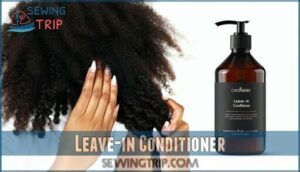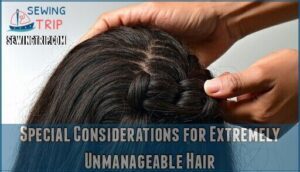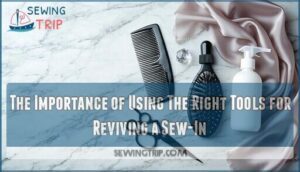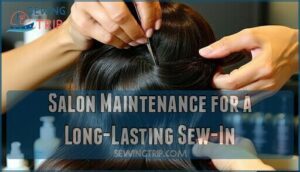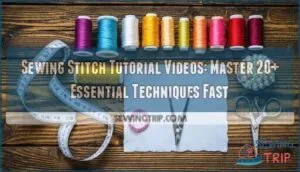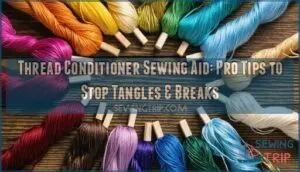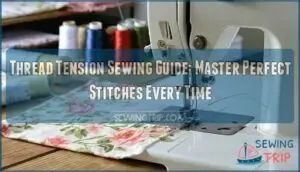This site is supported by our readers. We may earn a commission, at no cost to you, if you purchase through links.
 Your sew-in doesn’t have to stay tangled and lifeless. Start by gently detangling with a wide-tooth comb, working from tips to roots.
Your sew-in doesn’t have to stay tangled and lifeless. Start by gently detangling with a wide-tooth comb, working from tips to roots.
Use sulfate-free shampoo every 7-10 days to cleanse without stripping natural oils. Apply a nourishing leave-in conditioner while damp, focusing on mid-lengths and ends.
Deep condition weekly to restore moisture and shine. When you revive sew in extensions properly, you’ll breathe new life into tired hair.
Air-dry when possible, or use low heat with a heat protectant. Don’t forget to sleep on silk pillowcases to reduce friction.
The secret lies in consistent care and the right techniques that transform dull weaves into stunning, manageable hair, giving you a chance to revive your sew-in and make it look stunning with proper techniques.
Table Of Contents
- Key Takeaways
- Detangling Techniques for Reviving a Sew-In
- Proper Cleansing and Moisturizing of a Sew-In
- Drying Methods to Maintain The Integrity of a Sew-In
- Boiling With Silicon Mix for Reviving a Sew-In
- Special Considerations for Extremely Unmanageable Hair
- The Importance of Using The Right Tools for Reviving a Sew-In
- Salon Maintenance for a Long-Lasting Sew-In
- Understanding Style Revive and Sustainable Sewing Projects
- Sewing Insights and Expertise From Meg Healy
- Frequently Asked Questions (FAQs)
- Conclusion
Key Takeaways
- Start by gently detangling your sew-in with a wide-tooth comb, working from tips to roots, and use sulfate-free shampoo every 7-10 days to cleanse without stripping natural oils.
- Apply leave-in conditioner to damp hair focusing on mid-lengths and ends, then deep condition weekly to restore moisture and shine to your extensions.
- Air-dry whenever possible or use low heat with a heat protectant, and sleep on silk pillowcases to reduce friction and prevent tangling overnight.
- For severely damaged sew-ins, try the Silicon Mix boiling method – simmer your weave in boiling water with Silicon Mix for 30 minutes to remove buildup and restore softness.
Detangling Techniques for Reviving a Sew-In
When your sew-in looks like it’s been through a windstorm, don’t panic – proper detangling can work miracles.
Start with finger detangling to gently separate the worst knots before reaching for tools. This prevents unnecessary breakage and stress on your extensions.
Gentle fingers work miracles where harsh tools fail—patience saves your weave from unnecessary damage.
Next, sectioning hair into manageable parts makes the process less overwhelming. Work from bottom to top, using gentle motions with a wide-tooth comb. Never rush this step – patience prevents damage.
Apply leave-in sprays to add slip and moisture, making knots easier to release. Focus on one section at a time, holding hair firmly at the root to avoid pulling on your scalp.
With proper sew in detangling techniques, you’ll transform tangled weave revive disasters into smooth, manageable hair extensions care success stories.
Proper Cleansing and Moisturizing of a Sew-In
Once you’ve detangled your sew-in, proper cleansing becomes your next essential step to restore its original bounce and shine.
You’ll need the right combination of sulfate-free shampoos, deep conditioning treatments, and leave-in products to bring your weave back to life without causing damage or dryness, using the right techniques for deep conditioning.
Sulfate-Free Cleansers
Once you’ve detangled your sew-in, choosing the right cleanser becomes your next priority.
Sulfate-free shampoo protects natural oils while maintaining hydration balance in your extensions. These gentle formulas prevent scalp sensitivity and support color retention better than harsh alternatives.
To find the best options available, consider exploring online resources.
Apply your sulfatefree shampoo directly to braided sections, focusing on hair shampooing techniques that cleanse without stripping. This sew in cleaning method keeps your weave fresh and manageable.
Deep Conditioning
Your weave’s thirst runs deeper than surface-level cleansing can satisfy. Deep conditioning transforms brittle strands into silk-soft perfection through intensive moisture balance and strategic heat application.
This powerhouse treatment penetrates each fiber, restoring elasticity while preventing future breakage.
- Apply moisturizing conditioner from mid-length to ends, avoiding roots
- Use protein treatments monthly to strengthen damaged cuticles
- Cover with plastic cap and apply gentle heat for 15-20 minutes
- Choose product ingredients like keratin, argan oil, and shea butter
- Create DIY masks using honey, avocado, or coconut oil for natural nourishment
Leave-in Conditioner
After shampooing and deep conditioning, apply leave-in conditioner from mid-length to ends for ideal hair hydration.
Focus on product ingredients like proteins and oils that boost hydration levels while providing frizz control.
This application method enhances curl definition and makes hair detangling easier.
Remember to also massage hydrating oils onto the scalp weekly.
Your sew in refresh routine isn’t complete without this essential sew in moisturizing step that maintains manageability between washes, ensuring proper hair care.
Drying Methods to Maintain The Integrity of a Sew-In
After cleansing your sew-in properly, how you dry it makes all the difference between healthy hair and a tangled mess.
Air drying is your best friend for sew in maintenance – it preserves the hair’s natural texture without causing heat damage that leads to frizz and breakage.
Start by gently squeezing out excess water with microfiber towels, which absorb moisture without roughing up the cuticles like regular terry cloth.
If you’re pressed for time, use a blow dryer on low heat settings while keeping it moving constantly. Focus on root drying first, as trapped moisture near your scalp can cause bacterial growth and unpleasant odors.
To facilitate thorough drying, you can also part the weave to improve airflow.
Never go to bed with damp hair – this creates the perfect environment for product buildup and mildew.
Proper hair drying techniques are vital for effective sew in care and will keep your weave looking fresh longer.
Boiling With Silicon Mix for Reviving a Sew-In
Proper drying sets the foundation, but sometimes your sew-in needs more intensive care. Silicon Mix becomes your secret weapon for dramatic hair revival when regular conditioning isn’t enough.
Start by filling a large pot with water and heating it to boiling temperature. Add one container of Silicon Mix ($5.99) along with a small amount of dish soap. This affordable deep conditioning treatment works wonders for restoring shine and bounce to tired extensions.
Gently lower your weave into the boiling mixture, ensuring complete coverage. Let it simmer for 30 minutes, stirring occasionally to prevent tangling. The heat opens hair cuticles, allowing Silicon Mix benefits to penetrate deeply into each strand.
To maintain the hair’s natural oils, consider using sulfate-free cleansers. After boiling, rinse thoroughly with lukewarm water and follow with regular shampoo. This hair boiling method removes stubborn buildup while infusing moisture back into your weave.
Your sew-in revival is complete when extensions feel soft and manageable again.
Special Considerations for Extremely Unmanageable Hair
When your sew-in transforms into a tangled nightmare, you’re dealing with more than just bad hair days. Severe tangling and extreme dryness signal that your weave needs intensive intervention beyond standard care routines.
Start with scalp sensitivity assessment before applying any products. Itchy, irritated skin means you’ll need gentler formulations. Product buildup often creates a vicious cycle—your sew in itch worsens, leading to more scratching and damage.
Combat breakage control issues by sectioning hair into manageable portions. Apply a protein-rich sew in conditioner to strengthen weakened strands. For stubborn knots, use a detangling spray and work from ends upward with patience. To help minimize frizz, consider gentle air-drying techniques.
Address dry sew in problems with overnight deep conditioning treatments. Wrap sections in plastic to lock in moisture. Remember, attempting to revive sew in hair that’s severely compromised might require professional help. Don’t risk further damage by forcing aggressive techniques on fragile extensions.
The Importance of Using The Right Tools for Reviving a Sew-In
You can’t revive a tired sew-in without the right tools in your arsenal.
The proper equipment makes the difference between a frustrating hair care session and a smooth transformation that leaves your weave looking fresh and manageable.
Paul Mitchell Wide Tooth Detangler Comb
When unmanageable hair feels like wrestling with tangled yarn, the Paul Mitchell Wide Tooth Detangler Comb becomes your secret weapon.
This professional-grade tool transforms your revive sew in routine through its antimicrobial comb material and wide-tooth design that reduces breakage by 50%.
Here’s why this comb excels for weave maintenance:
- Comb durability withstands daily use without wearing down
- Detangling benefits work on all hair types, wet or dry
- Proper usage distributes treatments evenly through sew in extensions
The antimicrobial plastic construction prevents bacterial growth while gliding painlessly through stubborn knots.
A clarifying shampoo wash can further revitalize the weave.
Silk Queen Pillowcase
Beyond your detangling comb, nighttime protection transforms your weave maintenance routine.
Silk pillowcases deliver remarkable silk benefits that extend weave longevity through friction reduction. Unlike cotton, silk’s smooth surface prevents hair hydration loss while you sleep.
Some users also report experiencing noticeable skin benefits from using silk pillowcases.
| Benefit | Cotton Pillowcase | Silk Pillowcase |
|---|---|---|
| Friction Level | High – causes tangles | Low – smooth gliding |
| Moisture Retention | Absorbs natural oils | Preserves hair hydration |
| Weave Longevity | Shortens lifespan | Extends wear time |
| Nighttime Protection | Minimal defense | Maximum sew in extensions care |
This simple switch revolutionizes your weave refresh strategy, ensuring your sew in extensions wake up manageable and lustrous.
Salon Maintenance for a Long-Lasting Sew-In
You’ll need professional salon visits every four weeks to keep your sew-in looking fresh and healthy. Regular touch-ups, readjustments, and strategic trimming prevent damage while extending your weave’s lifespan substantially.
Touch-Ups and Readjustments
Regular touch-ups keep your sewin looking fresh and secure.
Schedule appointments every four to six weeks to maintain your weave’s professional appearance. Your stylist will assess track alignment and perform weave tightening where needed.
Professional maintenance addresses common issues that develop over time:
- Extension Security – Reinforcing loose tracks that may have shifted or loosened
- Closure Maintenance – Adjusting lace frontals and closures for seamless blending
- Hair Installed positioning – Realigning extensions that have moved from their original placement.
These adjustments prevent damage to your natural hair while extending your weave care routine’s effectiveness.
Trimming
Professional trimming transforms your sewin from tired to terrific.
Schedule trim appointments every 6-8 weeks to maintain shape and remove split ends.
Your stylist will assess layering techniques and blending weave seamlessly with natural hair.
Proper hair extensions care includes regular trimming ends to prevent further damage.
| Trimming Benefits | Your Hair’s Transformation |
|---|---|
| Split End Removal | Silky, smooth texture returns |
| Shape Maintenance | Professional, polished appearance |
| Layering Techniques | Natural movement and flow |
| Blending Weave | Seamless integration with natural hair |
| Trim Frequency | Fresh, healthy-looking hair extensions |
The key to great hair is regular trimming, which helps in split end removal, maintaining a professional appearance, and ensuring natural movement and seamless integration with your natural hair.
Understanding Style Revive and Sustainable Sewing Projects
You can extend your sew-in’s lifespan by learning sustainable styling techniques that work with your hair’s natural texture and growth patterns.
These eco-friendly methods help you refresh your weave while reducing waste and maintaining healthy hair underneath.
Style Revive With Meg Healy
Looking beyond salon maintenance, you’ll find inspiration in sustainable fashion approaches.
Meg Healy’s Expertise transforms worn garments into fresh styles, bridging hair care routines with eco-conscious sewing.
Her Refashioning Inspiration connects to the Sewing Community through innovative techniques.
- Maternity makeovers: Convert old jeans into stylish maternity wear
- Embroidered keepsakes: Create quilted pieces featuring ultrasound imagery
- Sustainable Fashion: Master Upcycling Tutorials for wardrobe renewal
Sustainable Sewing for Expectant Mothers
Expectant mothers can embrace eco-friendly fabrics and comfortable designs while creating sustainable maternity wear.
You’ll find adjustable patterns perfect for growing bumps, using non-toxic dyes for baby-safe sewing projects.
Just like reviving your sewing or hair extensions requires gentle care, maternity sewing demands thoughtful material choices, which is similar to the careful attention needed for hair weave maintenance and proper shampooing techniques.
Previous DIY Projects
Beyond maternity wear adaptations, Meg Healy’s previous seasons showcase impressive hair restoration techniques that mirror sewin revival principles.
Her DIY Materials approach transforms damaged extensions into fresh styles through strategic hair rejuvenation methods.
- Project Inspiration: Revive matted weaves using gentle detangling compounds
- Skill Level: Beginner-friendly techniques for hair transformation success
- Time Commitment: 2-3 hours for complete hair care transformation
- Cost Analysis: Budget-friendly alternatives to salon treatments
- Professional-grade results achievable at home
Sewing Insights and Expertise From Meg Healy
You’ll discover practical techniques from Meg Healy’s studio that transform tired sew-ins into fresh, manageable styles using simple refashioning methods.
Her expert approach combines traditional sewing skills with modern hair care knowledge, giving you the tools to extend your weave’s life while maintaining professional results, using simple refashioning methods is not the focus, instead the key is in the approach.
Meg Healy’s Studio Loft and Refashioning Methods
Meg Healy’s Studio Loft Tour reveals her Refashioning Inspiration through organized creative spaces.
Her Upcycling Expertise transforms forgotten fabrics into stunning pieces, much like reviving tired hair weave extensions.
Healys Design Philosophy centers on sustainability and resourcefulness—principles that apply to hair weave maintenance too.
The Sewing Community celebrates her innovative approach to giving materials new life.
| Space | Tools | Purpose |
|---|---|---|
| Cutting Station | Rotary Cutters | Precision Fabric Prep |
| Design Corner | Sketch Pads | Creative Planning |
| Storage Area | Clear Bins | Material Organization |
| Work Surface | Cutting Mats | Project Assembly |
| Inspiration Wall | Mood Boards | Visual Reference |
Tips From Husqvarna Viking for Upcycling Projects
When you’re ready to transform your fabric stash, Husqvarna Viking’s sewing machine tips make sustainable fashion projects effortless.
These garment refashioning techniques work perfectly for upcycling denim and creating fabric scrap ideas:
- Digitize vintage family heirlooms into one-of-a-kind embroidery designs
- Upcycle denim with free-motion quilting and appliqué accents
- Transform outdated curtains into quilted wall art
Online Sewing Classes and Tutorials
Pattern adjustments and virtual fitting sessions transform your sewing game through online classroom alternatives.
You’ll master hair weave maintenance techniques alongside traditional garment construction.
These digital tutorials offer skill development opportunities that complement your sewin care routine.
From hair extensions styling to creative project inspiration, online learning bridges the gap between hair weave maintenance and sustainable fashion creation.
Frequently Asked Questions (FAQs)
What are some good protective hairstyles I can wear in between sew-in installations?
Try protective braids, twist-outs, or low buns to give your natural hair a break.
These styles reduce manipulation and heat damage while promoting healthy growth.
You’ll keep your hair strong and ready for your next sew-in installation perfectly.
How often should I wash my sew-in?
Like tending a garden that blooms with proper care, your sew-in thrives with regular washing.
You’ll want to shampoo twice weekly using sulfate-free products, or once weekly if you’re hitting the gym regularly.
Can I swim with a sew-in installed?
You can swim with a sew-in, but protect it first. Wear a swim cap or apply leave-in conditioner beforehand. Rinse immediately after swimming and deep condition to remove chlorine damage.
What causes my sew-in to smell bad?
Your sew-in becomes a breeding ground for bacteria when moisture gets trapped underneath.
Poor drying after washing, sweat buildup, and infrequent cleansing create odors.
Wash twice weekly and make certain of complete drying to prevent these issues.
How long can I keep sew-in extensions?
You can keep sew-in extensions for six to eight weeks maximum.
After that, your natural hair needs breathing room and the weave requires removal to prevent damage, buildup, and potential scalp issues.
Why is my sew-in shedding excessively?
Your weave’s acting like autumn leaves falling endlessly.
Excessive shedding usually means you’re detangling too roughly, using harsh products, or your extensions are poor quality.
Switch to sulfate-free shampoo and gentle wide-tooth combing techniques.
Conclusion
Studies show that properly maintained sew-ins can last up to 12 weeks longer than neglected ones.
You’ve now learned the essential techniques to transform your tired weave into gorgeous, manageable hair.
Remember to detangle gently, cleanse with sulfate-free products, and deep condition weekly.
Don’t skip the heat protection and silk pillowcases – they’re game-changers.
With consistent care and the right tools, you’ll master how to revive sew in extensions and keep them looking fresh between salon visits.



